Malachite Uses: A Comprehensive Exploration
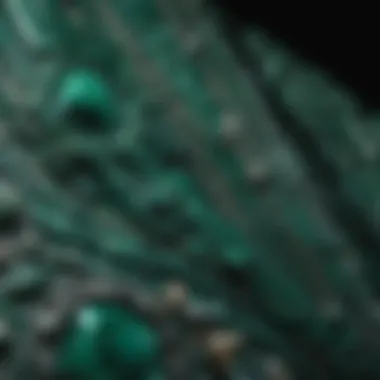
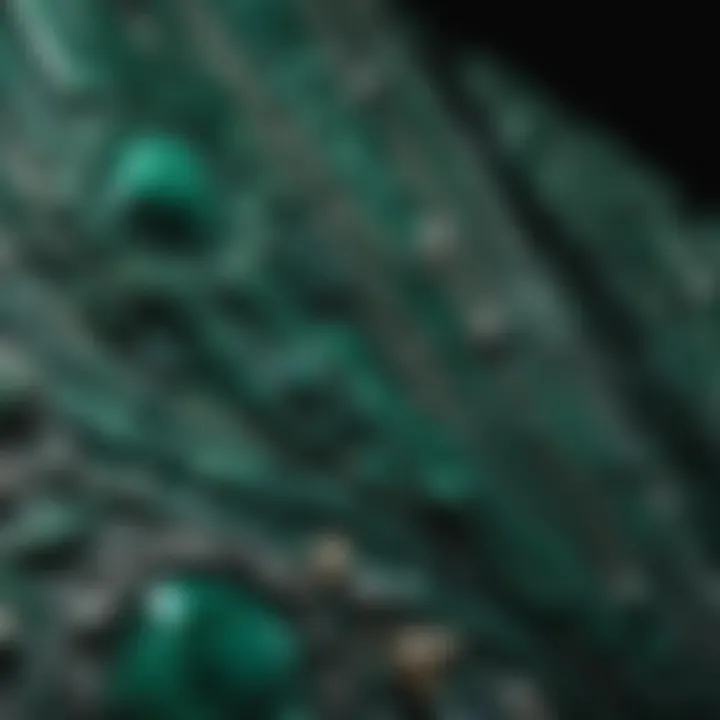
Intro
Malachite, often recognized for its vibrant green tones, isn't just a pretty face in the world of minerals. It boasts a rich tapestry of uses that extends across history, art, construction, and even the realm of alternative healing practices. This article embarks on a journey to uncover the multifaceted applications of malachite, shining light on its significant role throughout the ages as well as in the modern context.
Beyond its appeal as a collectible stone for enthusiasts, malachite's historical significance is profound. Cultures across various continents have revered this mineral, often attributing magical properties to it. Presently, it continues to capture the imagination of artists, artisans, and holistic practitioners alike. With this article, we aim to provide an extensive guide that not only explores malachite’s practical applications but also its metaphysical allure.
History and Origins
Overview of Collectibles, Rocks, and Fossils
Malachite, classified as a secondary mineral formed through the weathering of copper ore deposits, is widely sought after by collectors. Rock and fossil collectors often cherish this mineral for its striking banded appearance, which can range from light green to deep emerald shades. This distinctive look has made it a favorite not for just collectors, but also for jewelers and interior decorators.
- Collectible Aspects: Malachite is frequently carved into sculptures, beads, and inlay pieces.
- Common Finds: Brazil, the Democratic Republic of the Congo, and Russia are notable sources, providing a wide range of collectible specimens.
Historical Significance and Cultural Impact
The historical roots of malachite run deep. Ancient Egyptians adored this stone, often using it for cosmetic purposes and creating decorative items. It's fascinating to know that malachite pigment has its place in the art world, where it was ground to produce green paint used by artists through the ages. Its significance extends further; in Middle Ages, some believed that wearing malachite could ward off evil spirits.
"Malachite has been more than just a decorative stone; it’s been a talisman for protection and a canvas for expression across different cultures."
Identification and Classification
Guide to Identifying Rocks and Fossils
For rock enthusiasts keen on identifying malachite, it’s essential to understand its defining characteristics. When examining a specimen, look for:
- Coloration: Deep green to light green banding.
- Luster: Often has a vitreous to silky sheen.
- Hardness: Generally ranks at 3.5 to 4 on Mohs scale, making it relatively soft compared to other minerals.
Common Types and Variations
Different variations of malachite exist, with unique features such as:
- Banded Malachite: Exhibits concentric rings and varying tones, ideal for decorative arts.
- Malachite Pseudomorphs: Rare forms that have replaced other minerals while retaining the outer malachite structure.
Through this exploration, it becomes apparent that malachite’s applications have a rich context rooted in both historical traditions and contemporary practices. The unique characteristics and the cultural stories intertwined with this mineral not only enhance its practical uses but also develop a deeper appreciation among those who collect and study it.
Foreword to Malachite
Malachite is not merely a gemstone; it’s a dazzling window into the complexities of nature itself. Its vibrant green hues have captured the hearts of artisans, collectors, and scientists alike for centuries. This section lays the groundwork by introducing malachite, focusing on its multifaceted applications that have cemented its place in various cultures and contemporary uses.
Understanding what malachite is and the geological intricacies that underlie its formation gives us deeper insight into its significance. The beauty of this mineral tells a story—of ancient lands, skilled craftsmanship, and even the wisdom that some cultures attribute to its metaphysical properties. Familiarizing readers with malachite’s history and its uses establishes a context that highlights the importance of this remarkable stone.
One cannot overlook the aesthetic appeal it holds, serving not just as a decorative item but as a canvas for creative expression across various art forms. Moreover, the practical applications such as copper extraction further enhance its relevance in industrial contexts. An appreciation for malachite opens the door to understanding its place in both our past and present, prompting a discussion on how its allure extends beyond mere appearances to tap into deeper meanings in holistic practices.
By the end of this article, readers will gain a coherent view of malachite’s significance, not only in art and architecture but also in the realms of healing and sustainability.
What is Malachite?
Malachite is a copper carbonate mineral with a distinctive bright green coloration and intricate banding patterns. It has a chemical formula of Cu₂CO₃(OH)₂, revealing its dual composition of copper and carbonate. This mineral is often found in copper deposits and has been utilized since ancient times, not only for its beauty but also for its properties.
Geologically speaking, malachite forms in the oxidation zones of copper deposits. Its occurrence primarily in regions rich in copper, such as the Democratic Republic of Congo and parts of Russia, makes it geographically significant in the study of minerals.
People have been drawn to malachite's unique properties—both visual and functional. In terms of appearance, it's often polished into cabochons for jewelry or carved into intricate sculptures. But beyond this, malachite has intrigued many due to its supposed metaphysical properties, believed to provide a protective energy and facilitate emotional balance.
The Geology of Malachite
Malachite is more than just a pretty face; its geological birthright is equally fascinating. This mineral forms through secondary processes associated with the weathering of primary copper minerals. The primary ingredient in the creation of malachite is copper, often found in iridescent deposits. When these deposits weather over time, they undergo chemical changes that give rise to malachite, among other secondary copper minerals.
Typically, malachite is found in the upper zones of copper sulfur ores, often alongside azurite, another beautiful blue mineral. The combination of these two creates breathtaking specimens that are treasured by collectors. The structure of malachite can give insights into its formation, often presenting a fibrous texture and an array of concentric bands, which are the result of various environmental conditions during its growth.
Moreover, it's important to note that the extraction of malachite must be approached sustainably, considering its rarity and the environmental impact of mining. Understanding the geology of malachite leads one to appreciate the delicate balance between natural beauty and the need for responsible stewardship of these remarkable resources.
"By diving into the geology of malachite, we uncover not just the mineral's eligibility for artistic expression but also the house of cards that makes its beautiful existence possible."
In summary, malachite serves as a bridge linking its stunning aesthetics to its fascinating geological identity. This understanding sets the stage for exploring its historical significance and contemporary applications in the following sections.
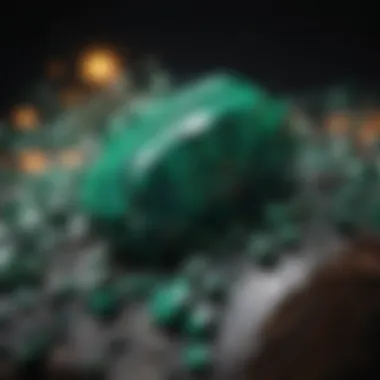
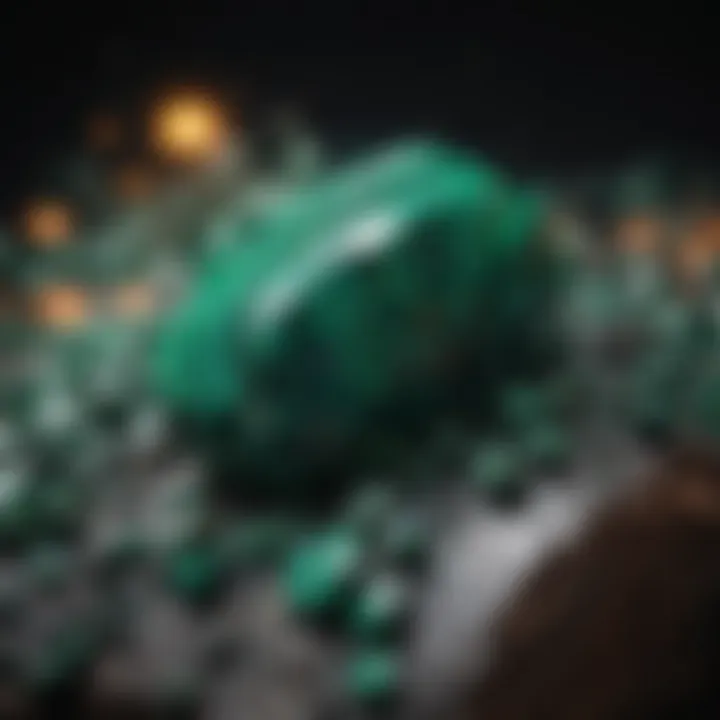
Historical Significance
Understanding the historical context of malachite adds depth to its multifaceted applications. This rich green mineral has been part of human civilization for thousands of years, serving not just practical uses but also holding great psychological and cultural importance. Exploring malachite’s journey through time helps unveil insights about our ancestors and their relationships with nature. The significance of malachite is evident in its utilization across various ancient societies, as well as its role in symbolic expressions that have been perpetuated through generations.
Malachite in Ancient Civilizations
Malachite has long been regarded as more than just a beautiful mineral; it held a deep significance in the ancient world. In Egypt, for example, malachite was prized for its striking hues and used in jewelry and artifacts. It is said that Egyptians utilized malachite dust as eyeshadow, believing it would protect their eyes from the sun's glare, along with offering spiritual safeguarding. The tomb of Tutankhamun showcased exquisite malachite pieces, hinting at its revered status among the pharaohs and high-ranking individuals.
In ancient Greece, malachite also earned its stripes. It found its place in the crafting of statues and decorative items, often associated with Aphrodite, the goddess of love and beauty. Their recognition of malachite's aesthetic and symbolic value speaks volumes about how cultures assigned meaning to this mineral long before modern society began to explore its benefits.
Beyond its beauty, the ancient peoples regarded malachite as a protective stone, and legends claim it can ward off negative energies. Multiple cultures, from the ancients of Mesopotamia to the Indigenous tribes of North America, championed malachite for its supposed mystical properties, often utilizing it in rituals or as amulets. Its presence in these ancient civilizations underscores not only its practicality but also its profound impact on their spiritual lives.
Cultural Symbolism
Cultural symbolism surrounding malachite runs deep, reflected in folklore, art, and even mythology. Often it symbolized transformation and protection, serving as a reminder of the balance between earthly experience and spiritual exploration. In many traditions, its deep green shades represented fertility and growth, a vital link to nature that cultures have revered since time immemorial.
Malachite frequently appeared in traditional healing practices, as healers utilized the stone to treat a plethora of ailments, believing that it possesses energy-boosting properties essential for recovery. In this context, malachite acted both as a physical remedy and as a psychological anchor, offering patients a sense of hope and connection to ancient traditions.
Furthermore, motifs inspired by malachite have persisted in various artistic endeavors, bridging the past and the present. From intricate patterns in Persian carpets to lush imagery in Renaissance paintings, the cultural significance of malachite resonates through artworks, asserting its influence over historical periods.
"Malachite serves as a bridge; a connection between our present and the influential legacies of the past. It embodies a wealth of spiritual and cultural heritage that continues to inspire people today."
In summary, understanding malachite's historical significance enables us to appreciate its timeless allure and ongoing relevance. It’s not just about the stone; it's about the stories it holds within, revealing the complex relationship humans have had with the earth and the treasures it offers.
Artistic Uses
When delving into the myriad of applications of malachite, one cannot overlook its artistic uses. This vibrant green mineral, with its unique banding and striking hues, has long inspired artisans and craftsmen across cultures. It embodies not just beauty but also significance, making it a favored material in varied artistic endeavors. The importance of malachite in art goes beyond its aesthetic appeal; it serves as a bridge between function and expression, establishing connections among cultures, time periods, and personal identity.
Malachite in Jewelry Making
Malachite is a treasured stone in the realm of jewelry making. Its vivid green tones are complemented by swirling patterns, which can make each piece truly one-of-a-kind. Jewelers often take advantage of malachite's properties to create everything from bold statement necklaces to delicate rings. Notably, the stone is relatively soft, which means it demands a careful approach in crafting. Small pieces are often polished to perfection, preserving their luster and enhancing their charm.
Benefits of using malachite in jewelry include:
- Visual Appeal: Rich green colors with deep banding patterns provide a striking visual that captures attention.
- Affordability: Compared to other gemstones, malachite is relatively inexpensive, making it accessible for both artisans and buyers.
- Symbolism: Many cultures attribute healing properties to malachite, relating it to protection and emotional balance, thus adding a deeper meaning to jewelry crafted from it.
While crafting, jewelers pay close attention to the stone's natural structural characteristics. Because malachite can scratch easily, it is often combined with more durable materials, providing a safeguard while maintaining the beauty of the mineral. The result is a harmonious blend of durability and artistry that can be worn for any occasion.
Decorative Arts and Craftsmanship
Beyond jewelry, malachite finds its way into various decorative arts and craftsmanship. Crafters harness its versatility to produce pieces that enhance aesthetics in homes and public spaces. Items like vases, coasters, and countertops made from malachite can transform an ordinary space into something extraordinary.
In decorative applications, malachite is often carved or inlaid, showcasing craftsmanship that reflects both skill and creativity. Artisans use it in:
- Tabletops: Often seen in luxury furniture, malachite tabletops add a rich color and texture that stands out in any room.
- Home Decor: Sculptures, lamp bases, and wall art utilize the mineral’s appeal to draw the eye and add elegance.
- Mixed Media Art: Artists often incorporate malachite dust or small pieces into their work, lending texture and depth to paintings or sculptures.
“The true beauty of malachite lies not just in its visual allure but in the story each piece tells—echoes of nature, history, and human creativity.”
As interest in sustainable and unique interior designs grows, malachite continues to find its niche. Increasingly, artisans are exploring more eco-friendly practices in sourcing and creating with this stone, merging environmental consciousness with aesthetic beauty.
Ultimately, the artistic use of malachite speaks to a broader conversation about material selection in art and design. The mineral's unique characteristics not only inspire creativity but also raise awareness about cultural heritage and sustainable practice, offering collectors a chance to appreciate both the beauty and story behind each piece.
Malachite in Architecture
Malachite, with its rich green hues and striking patterns, carries both aesthetic and functional significance in architecture. It’s not just a pretty stone; it brings a depth of character and luxury to various structures. Architects and designers alike appreciate malachite for its unique visual appeal and its ability to convey a sense of nature and culture in built environments. Understanding how malachite has been utilized throughout history and continues to be embraced in modern applications is essential for anyone interested in the intricate balance between natural resources and architectural innovation.
Historical Buildings and Structures
Historically, malachite found its place in a variety of architectural settings, particularly in grandiose buildings where it served as a symbol of opulence and design sophistication. For instance, the famous St. Isaac's Cathedral in St. Petersburg showcases malachite beautifully. The lavish green panels are integrated into the interior, creating a dramatic contrast with the cathedral’s golden decor. This exceptional use of malachite not only emphasizes the skill of artisans but also reflects a time when natural stones were held in high regard.
Malachite was also used in furnishings and smaller architectural elements, such as columns and decorative accents, which played a significant role in places like palaces and museums. The ability of malachite to be polished to a high sheen allows it to catch light and become a focal point in larger architectural designs.
"Malachite's allure isn't just in its color; it’s a testament to human creativity and artistry expressed through stone."
Contemporary Applications


In contemporary architecture, malachite has metamorphosed from being solely a historical artifact to a material enjoying a revival. Designers leverage its vibrant qualities in modern constructions, ranging from residential spaces to high-end commercial establishments. Its use as wall cladding or in tiles is gaining traction, imparting an earthy yet sophisticated feel to interiors.
Additionally, innovative techniques allow malachite to be incorporated in new ways, such as through backlighting for installations or as an inlay in furniture pieces. It's not unusual to find malachite patterns etched into countertops, offering both beauty and a conversation starter for guests. As sustainability becomes increasingly important, the rise of ethically sourced malachite also addresses concerns regarding environmental impact and mining practices.
The prospects for future applications of malachite in architecture appear promising, with trends leaning towards its incorporation in eco-friendly designs and smart buildings, creating spaces that are as responsible as they are stunning. This balance of beauty and sustainability ensures that malachite holds a significant place in architectural discussions for years to come.
Industrial Applications
The industrial applications of malachite speak volumes about its versatility beyond mere aesthetics. This vibrant mineral finds its way into several sectors, including mining and pigments, playing a cornerstone role in those industries. Understanding these applications can offer rock and fossil collectors insight into malachite’s enduring importance and economical relevance.
Copper Extraction Techniques
Malachite is more than just a pretty rock; it serves a functional purpose in the extraction of copper, a metal in high demand across various industries. The mineral contains high concentrations of copper carbonate and is often a primary ore for copper mining.
The extraction process typically involves several steps:
- Crushing - Malachite is crushed to break it down into smaller particles, which aids in enhancing the extraction process.
- Separation - The crushed mineral is subjected to a process called froth flotation. This involves mixing the crushed ore with water and chemicals to create a slurry. Air is introduced into the mixture, allowing the malachite particles to attach to air bubbles and float to the surface, where they can be skimmed off.
- Roasting - The concentrated malachite is then heated in the presence of oxygen to convert the copper compounds into metallic copper.
This intricate journey from rock to refined metal underpins the importance of malachite in industrial operations. The mining techniques adopted ensure not only the profitability of extraction processes but also the quality of the copper obtained, leading to a more efficient production line. Malachite's role here ensures that the metal remains one of the core building blocks of modern technology, construction, and manufacturing.
"Malachite's transformation from ore to copper symbolizes the mineral's duality—as a natural gem and an industrial asset."
Paints and Pigments
In the domain of paints and pigments, malachite has a history that traces back to antiquity. The rich green color provided by powdered malachite has been used historically to produce some extraordinary hues in art, making it a sought-after pigment. Today, the relevance of malachite in the pigment industry persists due to its natural properties.
Malachite's pigment has the following advantages:
- Vibrant Color - It provides a vivid and deep green shade, ideal for artistic works and decorative applications.
- Natural Source - Being a natural mineral, it tends to have a lower environmental impact compared to synthetic pigments.
- Stability - The pigment is relatively stable when exposed to light and air, making it suitable for a range of applications—from art supplies to industrial coatings.
Many artists and artisans still favor natural pigments over synthetic ones for purity in color and texture. In contemporary usage, malachite powder mixed with oil can create exquisite paint that adheres well to different surfaces. This makes it particularly attractive for restoration works where authenticity is vital. With increasing awareness of sustainable practices in the paint industry, malachite's role is poised to regain traction among suppliers and consumers alike.
With these vibrant industrial applications, malachite remains not only a beautiful ornamental stone but also a critical resource in various sectors. Its unique properties bridge the gap between artistry and functionality, ensuring its continued relevance in a shifting industrial landscape.
As collectors and enthusiasts delve into the many layers of malachite, it’s essential to recognize how the versatility of this mineral impacts numerous aspects of modern life.
Metaphysical Properties
Malachite, with its vibrant green hues and distinctive banding, is not just a treat for the eyes; it holds significant metaphysical properties that many believe can impact our emotional, physical, and spiritual well-being. In this section, we will delve into the deeper significance of malachite within holistic practices, particularly focusing on healing and chakra alignment. This exploration aims to provide rock and fossil collectors with an understanding of malachite’s multifaceted significance beyond its aesthetic allure.
Healing and Wellness
The healing properties of malachite are widely recognized within various holistic traditions. Many practitioners advocate for its use as a powerful stone for emotional healing. It is often described as a stone that can bring unresolved emotions to the surface for processing. People who work with malachite suggest that it can help one navigate through life’s ups and downs by fostering transformation and growth.
Some common beliefs about malachite’s healing properties include:
- Emotional Clarity: Malachite is thought to aid individuals in confronting emotional issues, allowing them to make sense of their feelings and encouraging them to let go of past traumas.
- Physical Healing: Many consider malachite to be beneficial for physical health, claiming its vibrations support the body’s healing processes, particularly involving the heart and lungs.
- Energy Balancing: Its powerful energy is believed to help balance and cleanse the body’s energies, promoting overall wellness.
To make the most of malachite’s potential for healing, enthusiasts often wear it as jewelry or carry it as a pocket stone. Its purported ability to absorb negative energy also makes it a favored choice in meditation practices, as it’s said to create a protective barrier around the user.
"Malachite has a knack for drawing out the shadows of your mind, making it a go-to for anyone looking to untangle emotions and find peace."
Chakra Alignment
When it comes to chakra alignment, malachite is often associated with the heart chakra due to its lush green color. This chakra, located at the center of the chest, governs love, compassion, and emotional balance. Many believe that working with malachite can enhance one's ability to love and open oneself to the possibility of giving and receiving love freely.
Key points about malachite’s connection to chakra alignment include:
- Heart Chakra Activation: Malachite is used to amplify the energy of the heart chakra, facilitating emotional healing and encouraging the release of negative feelings.
- Promoting Forgiveness: Practitioners say that this stone can assist in letting go of grudges and fostering forgiveness, which is crucial for emotional health.
- Enhancing Relationships: It is thought to help individuals connect with loved ones on a deeper level, nurturing empathy and understanding between partners, friends, and family.
- Meditation Aid: Many use malachite during meditation, placing it over their heart center to enhance their connection to their deepest emotions and their ability to express love and compassion.
Caring for Malachite
Caring for malachite is crucial for anyone who appreciates this stunning mineral. With its rich green colors and banded patterns, malachite serves not only as a decorative piece but also as a reflection of its geological and historical significance. To ensure that your malachite pieces retain their beauty and vitality, one needs to understand the essential cleaning and maintenance practices, as well as how to store them properly.
Cleaning and Maintenance
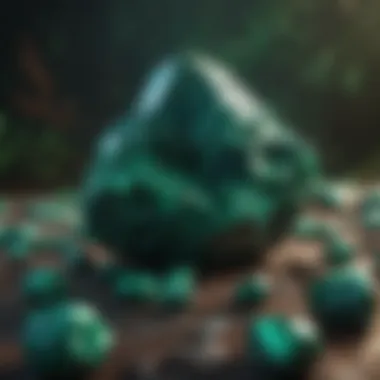
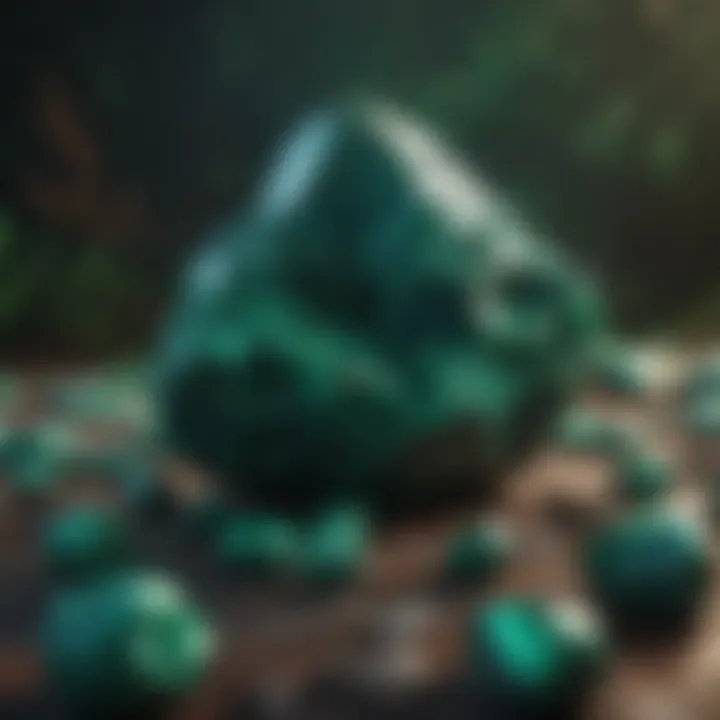
When it comes to cleaning malachite, one must tread carefully. This mineral is relatively soft, sitting at about a 3.5 to 4 on the Mohs hardness scale, which makes it prone to scratches and damage. Here are some effective cleaning strategies that will keep your malachite pristine:
- Use a soft cloth: A damp, lint-free cloth is ideal for wiping surfaces. Avoid abrasive materials that can mar the stone's finish.
- Avoid harsh chemicals: Sticking to mild soap and water is safer. Chemicals and even some household cleaners can harm malachite.
- Dry immediately: After cleaning, make sure to dry the stone thoroughly with a soft cloth as moisture can lead to tarnishing or potential damage.
- Use distilled water: If you need to rinse the stone, opt for distilled water instead of tap water to prevent mineral deposits from forming.
"Regular care not only enhances malachite's natural beauty, but also its longevity, turning it into a timeless piece of art."
Storage Considerations
Proper storage of malachite is another key element in its care. Mismanagement can lead to scratches, chips, or even fading. Here are some important pointers regarding storage:
- Store separately: Avoid placing malachite with harder stones or sharp objects that could scratch its surface.
- Use a velvet pouch: When not on display, keep malachite in a soft, cushioned pouch or a dedicated box to minimize exposure to dust and potential scratches.
- Keep out of direct sunlight: Sunlight can fade colors over time, so store your malachite piece in a dark or dimly lit area.
- Humidity control: Since malachite can be sensitive to humidity, consider storing it in a location where temperature and humidity levels are stable.
By following these care guidelines, you ensure that your malachite remains a striking element in your collection for years to come.
Collecting Malachite
Collecting malachite can be a rewarding endeavor, not just for its distinct green beauty but also for its rich history and varied applications. Many enthusiasts are drawn to the mineral for its striking appearance, which can be used in both artistic endeavors and as a conversation piece in home decor. The process of collecting malachite also opens doors to understanding geology, craftsmanship, and even holistic healing practices. The act transcends mere acquisition; it becomes a journey into the essence of this remarkable stone.
Valuation and Authentication
When embarking on the journey of collecting malachite, understanding its valuation and authentication is crucial. Genuine malachite can vary significantly in price based on factors such as color, patterns, and quality of the craftsmanship behind any jewelry or artwork that features it. Collectors should be wary of imitations, as synthetic and dyed materials can closely resemble authentic malachite yet lack its intrinsic properties.
Here are a few key points to consider:
- Color and Pattern: The richest malachite features deep, vibrant greens with distinct banding patterns. Look for uneven, fluid designs rather than uniformity, which may signal a synthetic counterpart.
- Weight and Feel: Authentic malachite is relatively heavy given its mineral composition. An unusually light piece may raise red flags.
- Expert Verification: Consulting with a gemologist can provide clarity. Getting an official appraisal helps establish the authenticity and value of the piece.
"In the world of mineral collecting, knowledge is your greatest ally. Always do your homework before making a purchase."
Popular Locations for Acquisition
Where one acquires malachite can greatly influence the quality and authenticity of the pieces collected. Several notable regions worldwide are famed for their rich deposits. Examples of such locations include:
- Congo: Known for producing some of the most vibrant malachite, Congolese specimens often boast striking patterns.
- Russia: The Ural Mountains have a historical significance in malachite mining, yielding both beautifully polished stones and rough specimens for collectors.
- Australia: Offers a variety of both raw and processed malachite often found in rock shops.
Proper research into reputable dealers and local rock shows can also lead to great finds. Connecting with local collectors through platforms like Reddit and specialized Facebook groups can provide insights and tips for navigating the collecting world.
Environmental Considerations
Understanding the environmental impact of malachite is essential in appreciating its various applications and ensuring its sustainability. As a popular mineral, especially noted for its striking green color, malachite provides not only aesthetic value but also raises important questions regarding the ecological footprint of its extraction and use. This section aims to shed light on the importance of sourcing malachite responsibly, recognizing the balance between demand and environmental stewardship.
Sourcing and Sustainability
The journey of malachite from the earth to the market is one that requires careful consideration. Sourcing malachite in a sustainable manner entails monitoring the conditions under which it is mined and ensuring that these practices do not detrimentally impact the environment. Some of the main points in this discussion include:
- Responsible Mining Practices: Engaging in ethical mining techniques that minimize soil erosion and damage to local ecosystems is crucial. Many companies are taking steps to rehabilitate mined areas and reduce their carbon footprint.
- Monitoring Supply Chains: Ensuring that malachite comes from suppliers who adhere to environmental standards can significantly influence sustainable practices. Traceability in supply chains allows consumers to support ethically sourced materials.
- Alternative Resources: Exploring synthetic options or recycled materials can reduce the demand for naturally mined malachite and alleviate pressure on the environment.
"Sourcing minerals in harmony with nature is both a responsibility and an opportunity for sustainable development."
Impact of Mining Practices
Mining malachite, like any mineral extraction, has potential negative consequences that need addressing. The methods used in mining can have far-reaching impacts on both the local environment and communities. The following points illustrate some of the core issues related to mining practices:
- Habitat Destruction: The excavation of malachite often leads to the disruption of local habitats, risking the biodiversity in those areas. With careful planning, mining entities can minimize damage and even contribute to habitat recovery efforts.
- Water Contamination: Mining processes might result in the release of pollutants into nearby water sources, harming aquatic ecosystems and posing health risks to local communities. Implementing strict waste management protocols is a necessary step to safeguard these resources.
- Community Health and Safety: Workers in malachite mining operations can face significant health risks if safety regulations are not enforced. Improving labor practices and providing protective measures ensures that the communities involved can thrive while contributing to the economy.
In sum, examining the environmental aspects of malachite sourcing and mining gives critical insight into the role of sustainability in mineral use. As the interest in malachite grows, the emphasis on responsible practices can help mitigate ecological issues while maintaining the mineral's majestic allure. Collectors and enthusiasts alike should strive for an appreciation that extends beyond its beauty to an understanding of the environmental narrative associated with it.
End
In summing up the discussion around malachite, it is crucial to emphasize the mineral's multifaceted significance across various domains. Malachite is not merely a visual marvel but stands as a testament to humanity's ongoing relationship with nature, art, and well-being. Its rich history and diverse applications illustrate how such a seemingly simple mineral can encapsulate complex ideas of beauty and function.
Reflecting on Malachite's Importance
Malachite’s importance extends beyond its captivating green tones and unique banding. It has played a pivotal role in ancient trade, adorned royal crowns, and graced the walls of grand structures. Collectors and enthusiasts value it not just for its aesthetic appeal, but also for what it represents: a blend of nature, art, and history. The popularity of malachite in jewelry making and interior design showcases its ability to elevate both personal style and living spaces.
In addition, the metaphysical properties attributed to malachite resonate with many who seek holistic approaches to health. Whether regarded as a healing stone or a tool for meditation, its presence in spiritual practices indicates a deep connection that cannot be overlooked. Collectors often seek out authentic and high-quality specimens to not only display but to integrate into their personal wellness routines.
Future Perspectives for Malachite
Looking ahead, malachite's future appears promising, especially with the growing appreciation for sustainable practices among collectors and artisans. As awareness around environmental concerns rises, the quest for responsibly sourced materials will influence how malachite is mined and marketed. This shift indicates a broader trend towards valuing not only the physical properties of minerals but also the ethical considerations of how they are acquired.
Additionally, the exploration of malachite in modern applications could open new doors. Its unique coloring and properties may inspire innovative uses in fashion, technology, and even art. The potential for new artistic expressions involving malachite can stimulate both creativity and appreciation in future generations.
In summary, malachite's journey is far from over. It continues to capture the interest of a discerning audience—those who understand that beauty can encapsulate deeper meanings and responsibilities. Its legacy will undoubtedly evolve, but the essence of malachite, like its rich green hues, will remain a cornerstone for future explorers and collectors alike.



